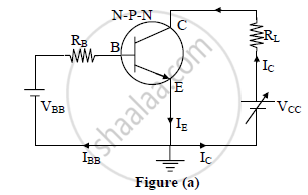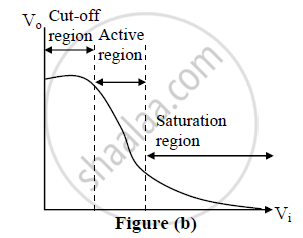Advertisements
Advertisements
Question
Explain the working of transistor as a switch.
Solution
Working of transistor as a switch:
a) A base-biased N-P-N common emitter transistor is as shown in figure (a).

b) On applying Kirchhoff ’s law in input circuit, we get,
VBB − IBRB = VBE
∴ VBB = VBE + IBRB
c) Considering VBB as the d.c input voltage ‘Vi’ then the above equation may be written as Vi = VBE + IBRB ….(i)
Applying Kirchhoff’s law in output circuit, we get,
VCE = VCC − ICRL
d) Considering VCC as the dc output voltage ‘Vo’ then the above equation may be written
as,
Vo = VCC − ICRC ….(ii)
As Vi is increased from 0 to 0.6 V (for silicon transistor), IC = 0 and the transistor is
said to be in the cut-off state.
∴ IC = 0
From equation (ii),
Vo = VCC = constant
f) As ‘Vi’ is increased from 0.6 V to 1 V, transistor will be in active state therefore IC
increases linearly. From equation (ii) ‘Vo’ decreases linearly. The transistor in this
range is called in active state.
g) If ‘Vi’ is increased further, ‘Vo’ becomes non-linear and decreases further and tends to
become zero, though its value nearly reaches zero. The transistor in this range is said to
be in saturation state. The above characteristics are shown in figure (b).

h) When Vi is low(< 0.6 V), Vo is high and when Vi is high (> 1 V), Vo is low. By defining
low voltage state as cut off state and high voltage level as saturation state, transistor can be used as a switch.
i) A low voltage input keeps the transistor in cut-off region (non-working) and the
transistor is said to be switched off.
j) A high voltage input keeps the transistor in saturation state (working) and the transistor
is said to be switched on.
